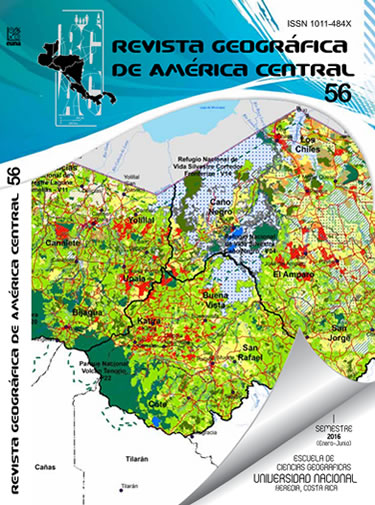ASSESSMENT OF THE FOREST COVER IN COSTA RICA: AN APPROACH USING CONSERVATION AREAS IN THE YEAR 2000
DOI:
https://doi.org/10.15359/rgac.1-56.7Keywords:
Forest Covert, Landscape ecology and environmental geographyAbstract
Over the past years, geography has faced a dizzying development related to environmental concerns facing today’s society. This is facilitated by the development of technological applications, which has expanded the geographical knowledge. Topics addressed within this trend include research on land use, which present detailed information and facilitate the monitoring of ecosystems, which is highly relevant in these days of accelerated climate change. This article analyzes the forest cover in Costa Rica during 2000, using Landsat images. Conservation areas as ecological regions that facilitate the analysis at this level are used in order to identify the local differences of the forest distribution. It is concluded that the country presents a high proportion of the forest cover especially of the low-density one that results from an accelerated process of natural regeneration, especially in some regions. This is related to changes in the economic model that has been oriented to the sector service to the detriment of agro-pastoral activities detriment as well as ecological factors that facilitate regeneration in tropical ecosystems. This research evidenced a reduced area of high-density forest cover by conservation region in comparison to the low-density one. However, the presence of fragments of dense forest with a medium to high surface -which are suitable for ecological conservation, prevails.
References
Alarcón, D., Anzueto, A., Galindo, A., García, J., Gómez, C., Porras, L., Ramírez, J., Santiago, J., Sarmiento, R., Trama, F., Sáenz, J. y Carrillo, E. (2003). Evaluación de la biodiversidad en el corredor biológico Corcovado-Piedras Blancas: Una perspectiva integral de paisaje. MINAE, INBIO, The Nature Conservacy y Maestría en Manejo de Vida Silvestre. Heredia, Costa Rica
Arroyo, J., Sánchez, A., Rivard, B., Calvo, J. y Janzen, D. (2005). Dynamics in landscape structure and composition for the Chorotega region, Costa Rica from 1960 to 2000. En Agriculture, Ecosystems and Environment, 106. 27-39.
Bennet, A. (2004). Enlazando el paisaje: El papel de los corredores y la conectividad en la conservación de la vida Silvestre. San José, Costa Rica: IUCN. 2000. El mito de la naturaleza intocable. Editorial Abya Ayala. Quito, Ecuador.
Calvo, A. y Ortiz, E. (2011). Fragmentación de la cobertura forestal en Costa Rica durante los periodos 1997-2000 y 2000-2005. En : Revista Forestal Mesoamericana Kurù,9. (22), pags.10-21. Instituto Tecnológico de Costa Rica. Cartago, Costa Rica.
Calvo J., Watson V., Bolaños R., Quesada C., Sánchez, A, Gonzáles P. y Ramírez, J. (1999). Estudio de la cobertura forestal de Costa Rica empleando imágenes Landsat 1986/1987 y 1996/1997. Documento presentado en el marco del XI Congreso Agronómico Nacional y de Recursos Naturales. San José, Costa Rica.
Fondo de Financiamiento Forestal de Costa Rica (FONAFIFO). (2012). “Estudio de la Cobertura Forestal de Costa Rica 2009-2010. En: htpp:minae.go.cr/recursos/documentos/coberturas-forestal/estudiocobertura-forestal-FONAFIFO-marzo-2012.pdf”.
Martínez, L., Palá, V. y Arbiol, R. (2004). Corrección atmosférica en espectro solar para series multitemporales. Aplicación a imágenes landsat 7 etm. Unidad de teledetección. Instituto Cartográfico de Catalunya. Barcelona. España.
Morera, C. (2010). Estructura del Paisaje y Desarrollo Turístico en la Fila Brunqueña, Costa Rica. Revista Geográfica de América Central, 44.91-108. Heredia, Costa Rica
Morera, C. y Sandoval, L. (2013). Los procesos de fragmentación y la conectividad forestal en Costa Rica: Dos casos de estudios. En: Geografia, Paisaje y Conservación. ECG - UNA. Heredia. Costa Rica.
Morera, C. y Sandoval, L. (2015). Aplicabilidad de indicadores de estructura de paisaje para evaluar transformaciones en escenarios tropicales. En: Métodos y Técnicas Geográficas Aplicadas al Ambiente: Una Visión Latinoamericana. Universidad Autónoma de San Luis Potosí, México. En prensa
Morera, C. y Sandoval, L. (2012). Estructura del paisaje y desarrollo turístico en Cahuita, Talamanca. En: Revista Geográfica de América Central, 48E. Escuela de Ciencias Geográficas, UNA. Heredia, Costa Rica.
Morera, C. Romero M., Miranda P., Avendaño D., Alfaro M. y Nuñez J.F. (2007). Análisis del territorio periurbano, actividades ecoturísticas y paisaje del GAM, Costa Rica. Informe Final. Licitación: ESAPEP-2006. PRUGAM. San José, Costa Rica
Sánchez, A. Foley, S. Hamilton, S. Calvo, C. Arroyo, P. y Jiménez, V. (2002). Estudio de Cobertura Forestal de Costa Rica imágenes Landsat TM/ para el año 2000. Centro Científico Tropical. San José, Costa Rica.
Tucker, C. y Southworth, J. (2009). Processos de mudanca florestal em nivel local e de paisagem em Honduras en Guatemala. En: Ecossistemas Florestais: interacao homem-mbiente. USPI. Sao Paolo, Brazil.
Vargas, G. (2008). Fragmentación y conectividad de ecosistemas en el sector del proyecto geotérmico Miravalles y sus alrededores. 1975- 2007. En: Revista Reflexiones, 87(2), 9-38.
Universidad de Alberta y Instituto Tecnológico de Costa Rica. (2006). Estudio de monitoreo de cobertura forestal de Costa Rica, 2005. San José: Universidad de Alberta, Canadá e Instituto Tecnológico de Costa Rica.
Food Agriculture Organization (FAO). (2015). http://ecoforestalia.blogspot.ca/2015/10/cuales-son-los-paises-masboscosos-del.html
Downloads
Published
How to Cite
Issue
Section
License
Proposed policy for journals offering Open Access
Authors publishing their works in the Journal acknowledge and agree to the following terms:
a) Authors retain the copyrights to their works and guarantee the Journal the right to be the first to publish their works, under the Creative Commons License Attribution-NonCommercial-ShareAlike 4.0 International, CC BY-NC-SA 4.0 International (https://creativecommons.org/licenses/by-nc-sa/4.0/deed.es), which allows others to share works upon complying with the acknowledgment of authorship and mention of the Journal as the original publisher of the work.
b) Authors are permitted to separately establish additional agreements for the non-exclusive distribution of the official edition of the work published in the Journal (for example, authors may desire to place the work in an institutional repository or incorporate it into a book that is to published elsewhere) so long they acknowledgment to recognize the Journal as the original publisher. The aforementioned additional agreements must respect the terms of the non-profit character and sharing philosophy of the original license (CC BY-NC-SA 4.0 International, https://creativecommons.org/licenses/by-nc-sa/4.0/deed.es).
c) Authors are encouraged to archive the post-print or editor/PDF version in Open Access repositories.






 REVGEO is licensed under https://creativecommons.org/licenses/by-nc-sa/4.0/deed.es
REVGEO is licensed under https://creativecommons.org/licenses/by-nc-sa/4.0/deed.es
.svg_4.png)

_(1).png)
_(1)_(1)_(1)_1.png)
(2)(1)(1)(1).png)
